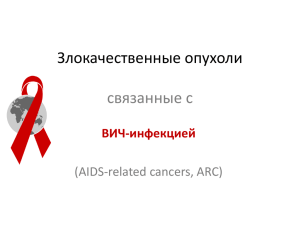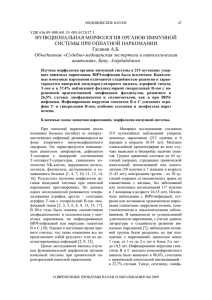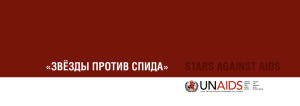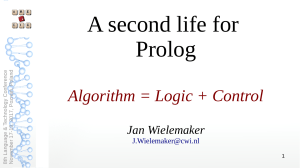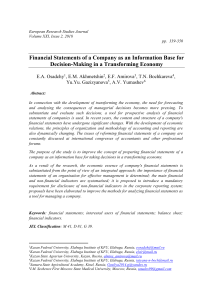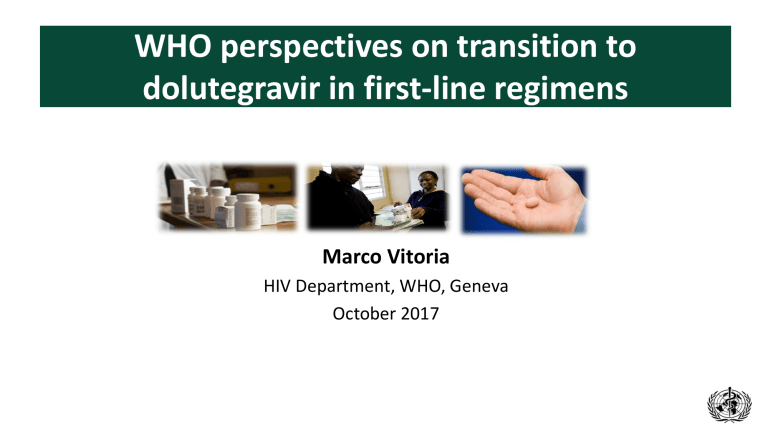
WHO perspectives on transition to dolutegravir in first-line regimens Marco Vitoria HIV Department, WHO, Geneva October 2017 ON TRACK TO REACH 30 MILLION PEOPLE ACCESSING TREATMENT… BUT NEED MORE WORK TO CLOSE THE GAP … Number of PLHIV on ART, 2000–2016 Number of new HIV infections ↑ 95% since 2010 Number of new HIV infections, 2000–2016 ↓ 18% since 2010 coverage on testing, treatment and viral suppression New HIV infections 2020 target Source: UNAIDS Global AIDS Update, 2017 Source: UNAIDS 2017 estimates. Global AIDS Monitoring, 2017. *The 2020 target is fewer than 500 000 new HIV infections, equivalent to a 75% reduction since 2010. Progress toward the 90-90-90 targets in Eastern Europe and Central Asia (2016) 63% 45% 77% [49-72%] [35-52%] [61-89%] of PLHIV have been diagnosed of diagnosed PLHIV receive treatment of people on treatment are virally suppressed ART coverage and AIDS related deaths in EECA (2000-2016) Use of antiretroviral drugs in EECA, 2016 Distribution of ART regimens Use of 1st line regimens 1% 7% 45% 28% 92% 1st line 2nd line 27% 3rd line TDF+FTC/3TC+EFV Regimen that includes LVP/r Other Slide includes data from 7 reporting countries (Armenia, Georgia, Kazakhstan, Kyrgyzstan, Republic of Moldova, Tajikistan and Ukraine). Key treatment and care messages from the 2016 WHO ARV guidelines • Treat all (at any CD4) - PLHIV across all ages, but the sickest remain a priority • Phased introduction of optimized regimens (new drug class; optimized dosing and formulations) as fixed-dose-combination • Task shifting, decentralization, integration to optimize the HIV care cascade (reduce late presentation, improve retention). Use of differentiated care packages. • Routine viral load as preferred approach for monitoring ART response (CD4 monitoring can be discontinued if virally supressed) WHO ARV Guidelines Evolution: 2002 to 2016 Topic When to start 2002 2003 2006 2010 2013 2016 CD4 ≤200 CD4 ≤ 200 CD4 ≤ 200 CD4 ≤ 350 CD4 ≤ 500 - consider 350 - TB at CD4 ≤ 350 - TB,HBV at any CD4 - CD4 ≤ 350 as priority - TB, HBV, PW, SDC at any CD4 Earlier initiation 1st Line ART - CD4 ≤ 350 as priority - Programmatic focus on KPs 8 options 4 options 8 options 6 options (FDC) 1 preferred option (FDC) 1 preferred option (FDC) - AZT preferred - AZT preferred - AZT/TDF preferred - d4T dose reduction - AZT/TDF preferred - d4T phase out - TDF/EFV preferred (all pops) - TDF/EFV preferred (all pops) - transition to new alternative ARV options Simpler treatment 2nd Line ART Treat All Boosted and non-boosted PIs Boosted PIs -IDV/r LPV/r, SQV/r Boosted PIs - ATV/r, DRV/r, FPV/r LPV/r, SQV/r (DTG, EFV400) Boosted PIs - Heat stable coformulation: ATV/r, LPV/r Boosted PIs -Heat stable co-formulation: ATV/r, LPV/r Boosted PIs - Heat stable co-formulation: ATV/r, LPV/r - new alternative options (DRV/r, LPV/r + RAL) Less toxic, more robust regimens 3rd Line ART None None None DRV/r, RAL, ETV DRV/r, RAL, ETV DRV/r, RAL, ETV, DTG Viral Load Testing No No (Desirable) Yes (Tertiary centers) Yes (Phase in approach) Yes (preferred for monitoring, use of PoC, DBS) Yes (preferred for monitoring, scale up all technologies) Better and simpler monitoring - CD4 monitoring can be stopped if patient virally supressed Vitoria et al , Curr Opin HIV/AIDS ,2013, 8: 12-18. Treat All Policy: uptake & implementation, July 2017 What is new in treatment & care (2017) ? Transition to new ARVs – clinical and programmatic considerations Transition to new antiretroviral drugs in HIV programmes: clinical and programmatic considerations is a available from the WHO webiste at: http://www.who.int/hiv/pub/toolkits/transition-to-new-arv/en/ ARV Drug Optimization: Key Principles Reduce toxicity Improve palatability/pill burden Increase resistance barrier Reduce drug interactions Safe use across different age groups and populations (“Harmonization”) Reduce cost Gallant, 2002 Summary of optimization profiles of new ARVs recommended in 2016 WHO ARV guidelines - comparative analysis Optimization criteria High virologic potency Efficacy and safety Low toxicity High genetic barrier to resistance Simplification Available as generic FDC Low pill burden Use in pregnant women Harmonization Use in children Use in HIV-associated TB Few drug interactions Cost Low price yes no ? ongoing studies DTG EFV400 DRV/r RAL ? ? ? ? ? Major gaps on clinical use of dolutegravir CNS side effects: higher than expected rate of DTG discontinuation due insomnia in cohort studies (higher rates compared with RCTs) but very low occurrence of other side effects. Risk of IRIS in PLHIV with advanced HIV disease: increased risk observed in cohort studies but not detected in RCTs with other INSTIs (REALITY trial) HIV-associated TB: need to adjust dose if rifampin is used (pK and clinical studies with ongoing) Pregnant/BF women: limited safety data .Very high DTG concentrations in blood cord at birth (pK and clinical studies ongoing) DTG for children: harmonization may be around the corner • Dosing and safety (IMPAACT P1093 trial) Expected completion May 2018 – Approval granted for ≥6 years and ≥ 15 kg (EMA) ≥30 kg (FDA) – Enrolment ongoing for infants starting at 4 weeks-6 months Extrapolation from adult efficacy appropriate • Efficacy in 1st and 2nd line (Odyssey trial) – Enrolled 329 (as of 19th July 2017) – PK sub-studies to investigate RIF interaction and WHO weight-band dosing Number of tablets or capsules by weight band once daily WHO weight-band dose (as endorsed by PAWG based on available PK data and use of WHO generic tool) Dispersible Tablet 5 mg Dispersible scored Tablet 50 mg 3–5.9 kg 6–9.9 kg 10–13.9 kg 14–19.9 kg 20–24.9 kg 25–34.9 kg 5 10 15 25 25 50 1? 2? 3? - - - - - - 0.5 0.5 1 Expected completion July 2020 (1st line by July 2018) Estimated timelines for completion of new clinical trials of DTG and EFV 400 ARV 2017 2018 Q3-Q4 DTG RADIO DAWNING ADVANZ-4 EFV400 SSAT 062 SSAT 063 Q1-Q2 IMPAACT 1093 Pregnant women 2019 Q3-Q4 DOLPHIN 1 NAMSAL Q1-Q2 2020 Q3-Q4 DOLPHIN 2 D2EFT INSPIRING Q1-Q2 VESTED ODYSSEY ADVANCE Q3-Q4 PANNA ING200336 NAMSAL Children TB Adults Adapted from Vitoria et al, Current Opinion HIV/AIDS, 12: 369-76 2017 Licensing and pricing of DTG in LMICs Country DTG U$ price (pppy) LMICs (generic) 48 - 60 396 - 1740 272 547 2200 2300 72 LMICs (originator) Botswana Brazil Mexico Belarus Tentative SRA Approval Timeline for DTG, TDF/3TC/DTG and TDF/3TC/EFV400 formulations* (2016-2019) Ukraine Sources: MSF, GFTAM, CHAI, MoH Brazil , Botswana, Mexico & Ukraine ARV 2016 H2 2017 H1 2018 H2 H1 2019 H2 H1 H2 DTG TDF/3TC/DTG TDF/3TC/EFV400 *Assumes SRA approval received 12 months after filing date Expected SRA approval of product by generic suppliers SRA approval received by generic suppliers TDF/3TC/DTG in 92 LMICs = 75 U$ pppy (Sep/2017) Toxicity monitoring and pregnancy safety surveillance approaches recommended for DTG Populations Adults, adolescents and children Pregnant/breastfeeding women and infants Surveillance approaches WHO supporting programmes Active ARV toxicity monitoring (CNS, IRIS, long term toxicity) ARV pregnancy registry and surveillance of congenital anomalies WHO global database for active DTG toxicity monitoring (in development) At: http://who.int/tdr/research/tb_hiv/en/ WHO/TDR global central database for the surveillance of drug safety during pregnancy At: http://who.int/tdr/research/tb_hiv/drug- safety-pregnancy/en/ Mother–infant pairs monitoring during breastfeeding *TDR Special Programme for Research and Training in Tropical Diseases (TDR) Pre-treatment HIVDR to EFV or NVP in first-line ART initiators in selected countries countries should consider using an alternative 1st-line non-NNRTIs regimen when national levels of NNRTI DR reach 10% DTG vs EFV vs LPV/r: brief comparative analysis Parameters DTG EFV LPV/r Tolerability Comments LPV/r : GI symptoms, dyslipidaemia ; EFV: CNS side effects ( depression) ; DTG: insomnia Risk of drug interactions DTG and LPV/r need dose adjustment in TB treatment using rifampicin Efficacy in TB Safe use in PW Poor outcomes with TDF/XTC + bPIs in PROMISE study DTG pK safety studies ongoing (FDA class B drug). BW programme and small cohorts showing similar outcomes when compared with EFV Safe for use in infants/children EFV approved for children >3 years. DTG approved in children > 6 years. LPV/r pellets formulations for infants recently approved. High genetic barrier to HIVDR Once daily regimen DTG registration in process in 24 countries in 2017 and expected in + 50 in 2018 Wide availability in LMICs Generic TDF/3TC/DTG available since Sep 2017. Availability as FDC Impact on ART sequencing DTG= 44 USD ppy; EFV= 55 USD ppy, LPV/r = 220 USD ppy TDF/3TC/DTG = 75 USD ppy TDF/3TC/EFV= 95 USD ppy Lower prices as generics Some programmatic factors that can influence the transition to DTG in 1st Line ART DTG introducing policy (eligibility criteria/priority populations) Regulatory issues: availability of low cost generic formulations (FDCs) Supply chain management (procurement preparedness, current stocks of EFV containing regimens) Pre-treatment levels of HIVDR to NNRTIs Programme monitoring for toxicity and pregnancy safety (pharmacovigilance) “Bandwidth” capacity to develop multiple implementation polices (training, logistic management, monitoring capacity, quality) 18 Key items that programmes need to consider for a safe transition to new first- line ARVs Optimization criteria Efficacy Safety Simplification Harmonization DTG containing regimens EFV400 containing regimens • Highly efficacy in context of NNRTI resistance (cost saving ), • Efficacy data on PW and TB co-infection pending • Efficacy data on PW and TB coinfection pending • Concerns with rising NNRTI resistance • Limited safety data in young children, pregnancy , TB co-infection and advanced HIV disease (IRIS risk) • Used for decades in LMICs and is proved safe in PW and PLHIV with TB. • Lower doses are better tolerated. • Generic FDC already available • No dose adjustment needed and maintenance of once daily dose • Limitations for use in all populations (young children, IDU ) some important drug interactions Favours DTG Cheaper than EFV600 but less potential for further cost reduction Favours DTG • Generic single formulation available, but FDC expected only in 2018 • Need dose adjustment in TB cotreatment (twice daily dose) • Strategically preferred choice in long term • Cost Preferred Choice • Cheaper than EFV600 and higher potential for further cost reduction (strong generic competition) • Favours DTG Favours EFV 400 Favours EFV400 WHO technical update on transition to new ARVs, 2017 Examples of scenarios and considerations for transition to new first-line ARV drugs Potential country scenarios Rapid transition to DTG Phased transition to DTG Factors that can prompt faster uptake Country level actions needed to support of new ARVs* introduction of new ARVs PDR to NNRTIs ≥10% Country has a policy for introducing DTG DTG generic FDC largely available DTG registered in the country Supply chain prepared for the transition PDR to NNRTIs <10% Country has a policy on introducing DTG DTG generic FDC available but limited DTG registered in the country High burden of TB/HIV and HIV in PW Supply chain not well prepared for the transition Transition to DTG could be delayed Transition to EFV400 can be considered PDR to NNRTIs <10% DTG generic FDCs not available EFV400 generic FDC available Country has no policy on introducing DTG PDR to NNRTIs <10% Supply chain system prepared for the transition EFV400 as FDC registered in the country DTG not registered in the country DTG generic FDC not available Transition to EFV400 should be reconsidered Country has no policy on introducing DTG DTG not registered in the country Supply chain not prepared for the transition PDR to NNRTIs ≥10% * Other programmatic factors : patient and clinician readiness to accept the new drugs, viral load suppression rates among those on ART, ability to monitor drug toxicity and supervision and monitoring of programme quality. WHO technical update on transition to new ARVs, 2017 How WHO support countries in transitioning to new ARV drugs? evaluating efficacy and safety data in clinical studies with new drugs providing guidance and tools for monitoring drug toxicity and HIVDR providing advice on how to phase in new drugs sharing country experiences http://www.who.int/hiv/pub/toolkits/transition-to-new-arv-technical-update/en/ DTG transition in LMICs: Key messages • DTG has clinical and programmatic advantages and can help countries to move faster towards 90/90/90 targets. • Some knowledge gaps in specific populations need to be solved to broad implementation of DTG as preferred option. • Several countries already started the transition to DTG using different strategies and their implementation process need to be closely monitored. • DTG transitioning programmes need to consider: local regulatory issues, importance of specific populations, supply chain readiness, drug toxicity and HIVDR monitoring capacity and country HIV policy priorities. • Pretreatment NNRTI resistance can be an accelerator to DTG transition in countries where this information is available. Other policy briefs released by WHO in July 2017 HIV drug resistance viral load and CD4 testing point-of-care tools for EID person-centred HIV patient monitoring Thank you PrEP implementation tool Advanced HIV disease Backup slides Advantages of DTG in context of IDU epidemic • Better tolerated (low incidence of side effects , including CNS side effects) • Higher genetic barrier and better sequencing potential • Low pill burden and OD schedule (generic FDC available) • Lower risk of drug interactions (safe use with opiods, anti-neoplastic, anti-depressive, oral contraceptives, hep C drugs, new anticonvulsants , recreational drugs) - major drug interactions: rifampin, carbamazepin, fenitoin, metformin • Can be used in TB co-infection (pK studies and emerging programme data showing efficacy with DTG dose adjustment) • FDA class B drug (emerging programme and cohort data suggest no clinical outcome differences when compared with EFV) • Included in WHO, EACS and DDHS guidelines, WHO EML, PEPFAR and GFTAM procurement lists • Lower price ( with potential for further reduction)
